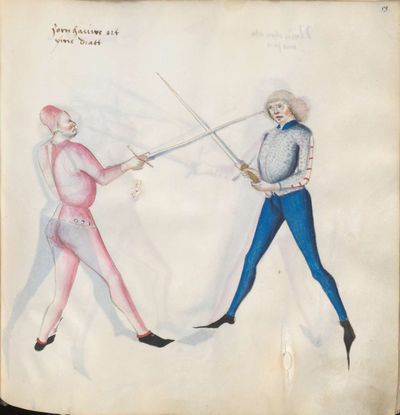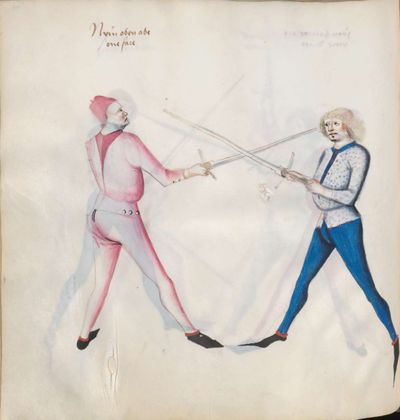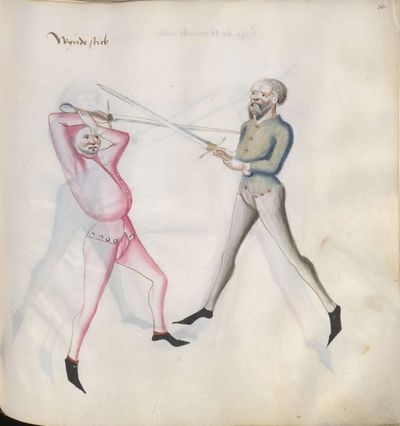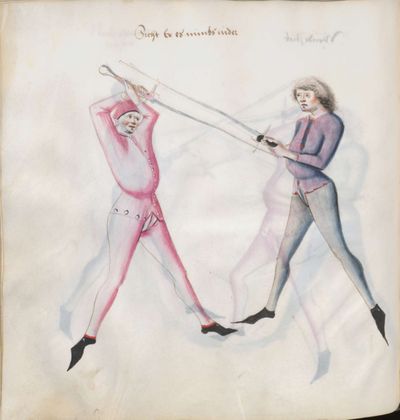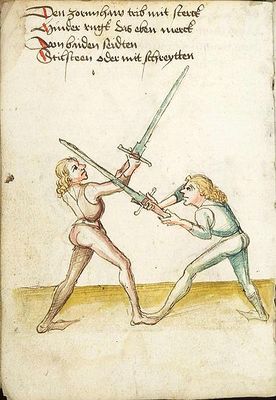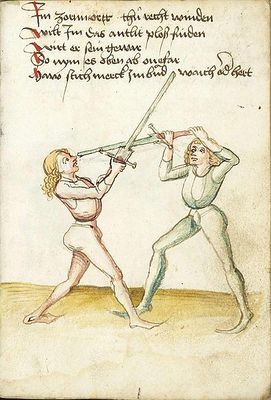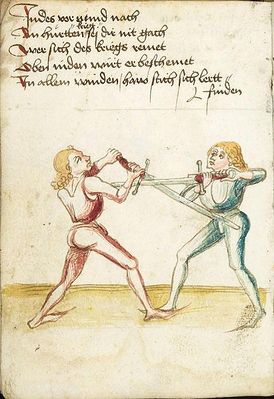|
|
You are not currently logged in. Are you accessing the unsecure (http) portal? Click here to switch to the secure portal. |
Zornhaw
The Zornhaw (Czornhaw, Tzoharn; "Wrath-Hew") is one of the several hidden strikes mentioned in Johannes Liechtenauer's Recital on unarmored long sword fencing.
Contents
Primary Sources
|}
|}
|}
|}
|}
Munich Version (ca. 1470) |
Bologna Version (1460-1480) |
Vienna Version (ca. 1480s) |
Gotha Version (ca. 1473-1503) |
Solothurn Version (ca. 1506-1514) |
| ||
|---|---|---|---|---|---|---|---|
The Wrath-hew Point threatens him. |
[59r] zorn hauwe ort yme dratt |
[19r] [No text] |
[63r] [No text] |
[32r] [No text] |
[077] [No text] |
||
Take off above without danger. |
[59v] Nym oben abe one fare |
[19v] [No text] |
[63v] [No text] |
[31v] [No text] |
|||
Wind, stab. |
[60r] Wynde stich |
[20r] [No text] |
[64r] [No text] |
[32v] [No text] |
|||
If he sees it, take it down. |
[60v] Sicht Er es nimbs nider |
[20v] [No text] |
[64v] [No text] |
[33r] [No text] |
Illustrations |
Archetype (1467) |
Kassel Version (1600s) |
Munich Version (1820)
| |
|---|---|---|---|---|
[5] Threaten him with the Wrath-point. |
[3r] Zorn ortt Im dröw. |
|||
[6] Yet another Upper-hew. |
Aber oberhout. |
|||
[7] The long Wrath-point. |
[3v] Das lang Zorn ortt. |
|||
[8] Therefore is the Crossed-point. |
Darfür ist das geschrenckt ortt. |
Illustrations |
Vienna Version (1495) | |
|---|---|---|
|
Deploy the wrath hew with strength. |
[02v] Den zornnhaw trib mit sterck | |
|
Do the right winding in the wrath point |
[03r] In zornnortt thu° recht winden | |
|
In-the-moment[1] before and after |
[03v] Indes vor vnnd nach |
Illustrations |
First Edition (1516) |
Egenolff's Edition (ca. 1531) |
Augsburg Manuscript (1564) |
French Translation (1538)
| ||
|---|---|---|---|---|---|---|
[87] About the wrath cut When you fence with someone and cut in with the wrath cut or however else down from above and they parry that and rise up with their arms and you both rush in on each other and they are then so circumspect that they will take your slice from below the hands into your arms, follow their sword downwards with your long edge and press down, thus you have broken them. |
Anger cut. When you engage with someone and strike him with an anger cut or however from high to low and when he defends against you, reaching with his arms upwards, and when both of you move in on one another; if he then wants to block or break your tip from below the hands in between to the arms, therefore follow his sword, pulling with the long edge, and press strongly down. Thus you have broken him. |
[36.2] Vom zorn haw Wan du mit ainem fichst, und haust ym ein mit dem zornnhaw, oder sunst von oben nider, vud er dir das verseczt, und fert hoch auff mit den armen, und lauft paidt einander ein, und ist er dan so fursichtig und will dir dein schnidt nemen under den henden in die armm, so volg seinem schwerdt nach undrsich mit der langen schneidt und truck nider, so hastus prochen |
[13v.6] Zornhaw. Wann du einem einhawest mit dem Zornhaw, oder sunst von oben nider, und er dir das versetzt, und feret hoch auff mit den armen, und lauffent bed einander ein, Ist er dann so fürsichtig, und [14r.1] wil dir dein schnidt nemen under den henden in die arm, so volge seinem schwerdt nach undersich mit der langen schneid, und truck nider, so hastus brochen. |
[61v.2] Vom zornnhaw Wan du mit ainem fichst vnd haust Im ein mit dem zornhaw oder sunst von oben nider, vnd er dir das versezt vnnd fert hoch auff mit den armen vnd laufft baidt einander ein vnd Ist er dan so virsichtig vnd wil dir dein schnit Nemenn vnnder deinen hendenn in den arm so volg seinem schwertt nach vnndersich mitt der lanngenn schneÿdtt vnnd truckh nider so hastus gebrochenn, |
[34.2] De coup courouche. Quant vous combatez avec aulcun & luy frappez dung coup courouche, ou ainsi de hault en bas, et quil le vous deffent, en tendant avec les bras en hault, et que tous deux entres lung sur laultre. Si alors il veult empescher ou rompre vostre taille dessoub les mains entre les bras suyuez adonc son espee tyrant en bas avec le long taillon, et pressez fort en bas & avez rompu. | |
[88] Another But when you arrive with your arms high and someone does as well and they rush in and want to bash you between the eyes or in the breast with their pommel through your arms from below your hands, speed downwards with your pommel, with your arms strong and heave towards yourself and strike them on their head with your sword. |
Another. Or when you come with the arms high and another does too and runs in at you, if he wants with the pommel through your arms and below your hips to bash into your face or the chest; then move in with the pommel strongly below your hands and in pulling towards yourself, strike with the sword on his head. |
[36.3] Ain Anders Wan du aber hoch mit den armen kumst, und ainer auch also, und laufft dir ein und wolt er dich den mit dem knopf durch dein arm͂ under deinen lenden, under die augen, oder in die prust stossen, so var undersich mit dem knopf starck mit den armen, vud ruck an dich, und schlach yn mit deim schwerdt auff sein kopf |
[14r.2] Ein anders. Wann du aber hoch mit den armen kompst, und einer auch also, und laufft dir ein, unnd wölte dich dann mit dem knopff durch dein arm under deinen lenden, under die augen, oder in die brust stossen, so far undersich mit dem knopff, starck mit den armenn, und ruck an dich, unnd schlahe ihn mit deinem schwerdt auff seinen kopff. |
[61v.3] Ain annders Wan du aber hoch mit denn armenn kumst vnd ainer auch also vnd laufft dir ein vnnd wolt er dich den mit dem knopff durch dein arm vnder deinen henden vnnder die augen oder In die brust stosenn so var vndersich mit dem knopff starckh mit denn armen vnnd ruckh ann dich vnnd schlach In mit deim schwertt auf sein ko[pf] |
[34.3] ¶ Ung aultre. Ou quant vous venez avec les bras en hault et ung aultre aussi vous courant ens. Si veult adonc avec le pommeau par vos braz dessoubz vos rains, ou en vostre visaige, ou boutez sur la poictrine. Alors entres avecq le pommeau fort en bas a tout voz mains et tirant vers vous, et frappez avec lespee sur la teste. |
Jörg Wilhalm Hutter's Treatise |
||||||||||
|---|---|---|---|---|---|---|---|---|---|---|
| Images
from the Munich Version |
Images | English Translation | Archetype (1523)
by Dierk Hagedorn |
Munich Version I (1523)
by Filip Lampart and Martin Fabian |
Glasgow Version (1533) | Munich Version II (1556) | Mair's Dresden Version (1542) | Mair's Vienna Version (1550s) [German] | Mair's Vienna Version (1550s) [Latin] | Mair's Munich Version (1550s)
|
[6r] Der statt im oberhaw
Das ist vom zornhaw wer dir oberhawet so nim den zornhaw starckh auff dein achseln vnd haw in schlecht hinein vber d[ie] versatzung vnd verheng vnd wind mit dem schwert als welte [?] dich zwerchen vnd lass obfallen zu baiden seÿtten mit hal[b] vellern vnd schlag in mit der langen schneid nach dem Rechten orr zu dem kopff hinweg |
[3r] Der stat im oberhaw
Das ist vom Zornhaw wer dir oberhawt so nim den Zornhaw starckh auff dein achseln und haw in schlecht hinein uber die versatsung und vorheng und wind mit dem schwert als welttestu dich Zwerchen und lass abfallen zu baiden seiten mit halben [voliern] und schlag in mit der langen schneid nach Dem Rechten Or zu dem Koppf [hinerg] |
[5v] | [98r] | [41r] Ein verkerter schnit mit anem [sic] ansetzen.
Item wann du Inn dem zufechten bist vnnd Ir baid zusamen kompt. das dein Linncke fuosz vorstat. so nimb der plosse. seinnes Linncken arms. mit deinnem schnidt war. vnnd setz Im mit der lanngen schneidin an. das Im das Kreitz an dem Elennpogen stee. vnnd scheub In also von dir. scheubt er dich dann also von Im. so nimb deinnen Linncken schennckel. vnnd vertrew dich auf deinnem Rechten. so gastu Im ausz dem schnidt. haw darmit zu seinner rechten seiten oben zu seinem kopf. so kumpt dein Linncker schennckel Inn dem haw wider hinfur. In dem volg mit dem rechten fuosz wider hinnach. vnnd haw In ausz der hut vom tag. mit Lannger schneid. zu seinem köpff. versetzt er dir das so haw. Im mit ainnem fligel haw zu seinnem rechten Arm. von vnnden ein. fert er dem haw. nach vnd will In verschieben. so haw Im mit kurtzer schneid zu der obern plosse. hawt er dir also ein. so stee mit deinnem Lincken fuosz vor vnnd zwirch Im zu seinner rechten seiten seinnes kopffs. |
[20r]Ein verkerter Schnit mit ainem ansetzen.
Item wann du in dem zufechten bist, und Ir baid zusamen kombt, das dein lingge fuß vorsteet. So nimb der plösse seines linggen arms mit deinem schnit war, und setz Im mit der lang schneid an, das Im das Creutz an dem elnbog stee, und scheub In also von dir. Scheubt er dich dann also von Im, so nimb deinen linggen schenckel, und vertree dich auff deinem rechten, so geest du Im aus dem schnit, haw darmit zu seiner rechten seitten oben zu seinem kopff, so kombt dein lingger schenckl in dem haw wider hinfür. In dem volg mit dem rechten fuß wider hinnach, und haw In aus der hut vom tag mit langer schneid zu seinem kopff. Versetzt er dir das, so haw Im mit ainem fligelhaw zu seinem rechten arm von unden ein, fert er dem haw nach, und will In verschieben, so haw Im mit kurtzer schneid zu der oberen plösse. Hawt er dir also ein, so stee mit deinem linggen fuß vor, und zwirch Im zu seiner rechten seitten seines kopffs. |
[20r] | [37r] | |||
[6v] Der stett im oberhaw
[D]as ist der zornhaw auff der lingken |
[3v] Der stat im oberhaw
Das ist der Zornhaw auff der lingken Seitenn und den selben nim von der lingken achseln und haw im schnel hinein lang zu dem kopff und vorheng und wind damit und lass aber dir [velld] läuffen und schlag aber wie vor gschriben stat hnd hindersich hinweg |
[6v] | [98v] | |||||||
[3r] Das ist der zorn ortt
Das ist die ausrichtung vnd merckh wer dir oberhawet das du im mitt dem zorn ortt eindringest vnd wirtt er des gewa[r] so nim es oben ab on gfar vnd bis starckh herwider wind haw vnd stich sicht ers so nim es nider das eben merkch haw stich schwech vnd sterckh vnd nims mit halben vellern vnd schlag aber hinein wie vor vnd hindersich hinweg |
[4r] Das ist der Zornortt
Das ist die ausrichtung und merckh wer dir oberhawt das du im mit dem Zornortt eindringest und wirtt er des gwar so ni es oben ab an gfar und bis starckh he[ ]wider wind haw und stich sicht ers so nim es und das eben merckh haw stich schwerth und starckh und win[ ] (wins, nims) mit halben vellern und schlag aber hinein wie vor und hindersich hinweg |
[7v] | [99r] | |||||||
[3v] Der stett im oberhaw
Das ist der ander zorn ortt auff der andern seÿtten den nim auch also wen sy gand baid wie der zornhaw von der achsel vn[d] mus ainer auss einem haw ain stich machen vnd mus den haw ver werffen vnd das nim auch flux hinweg wie das ober |
[4v] Der stat im oberhaw
Das ist der ander Zornortt auff der andern seitten den nim auch alss (also) wen sÿ gand baid wie der Zornhaw von der achsel und můs einer auf einem haw ain[ ]s[ ]ch machen und můss den haw verwerffen und das nim auch flu[ ] hinweg wÿe das obd |
[8v] | [99v] | |||||||
Glasgow Version (1533) |
Munich Version (1556)
| |
|---|---|---|
| This is Jobst von Wirtenberg’s recital instructions with the long sword
Item. It is to be known that five hews are with the short edges. The first, the wrath-cut. The second, the fool. The third, the crooked-cut. The fourth, the war-cut. the fifth, the ox and plow. And thereafter the four oppositions[3] Two below, two above. And upon each art and and [sic] opposition[3], you may execute the art in the recital. In the first, the wrath-cut and thereafter the work. And thereafter the overwhelming and whoever yet opposes[3] you, the nearing breaks the art. If someone overwhelms you, so take his sword from him. Execute the wrath-cut as you are then nearing upon the man.. The fool is quite good opposing from the man, if you would like to execute art. The crooked-cut serves[4] certainly or injuriously upon the winding. The war-cut serves[4] injuriously upon the crooked-cut and when you engage his sword, you must wind. If the ox and plow venture out[5] well, you may overwhelm any hew. It is to be known when you strike someone with the wrath-cut into the sides, you must really lighten[6] upon his. If he strikes you second in the other side, oppose it between you and yourselves both, so approach and shove the sword on his neck and do not forget when you hew with the sword from the man that he does not pursue you and whatever you fence, fence with the pommel high in the air and free. This is the short recital with the short edge that you do not entirely sever him. |
[172v] Das ist maister jobst võ wirtenberg zetel gewesen mit dem langen schwert
Item es ist zü wisen das finf haw send mit der kurtzen
schneÿden / der erst der zorn haw / der ander der alber / der
drit der krumbhaw / der viert der krieg haw / der funft
der ochs und pflüg / und darnach die vier versazung
zuoñ unden zuoñ oben und auf iecklicher |
[66r] Das ist maister Jobst von Wirtenberg Zettel gewesen mit dem langen Schwerts
Item ist zu wisen das funf haw sind mit der kurzen schniden der erst der Zorn haw, der andere der alber der drit der krumphaw, der viert der Krieghaw, der funft der ochs und pflug unnd dernnach die versatzung zu unnden zuon oben, unnd auß jeglicher kunst und versatzung magstu die kunst treiben auss dem zettel niden muß[?] der Zornhaw unnd darnach die arbait unnd darnach die uberfallung unnd wene dir aber versatzt die nehe bringt die kunst aber felt dich[ ]einer so nimm im sein schwert den Zornhaw treib nit dan du sprignst nahent bey dem man der alber ist gut zu zu ochs versatzung von dem man magstu kunst treiben der krumphaw damit wol ochs far auff das wennden der krieghaw damit far auff dem krumpthaw unnd wan du sein schwert nimst so magsto wenden den ochs und pfluig kommt wol auss alle hew du magst einfallen er ist zu reisen wan du ainen mit dem kru Zornhaw in die seitten schlegst so mustu gar gering auff sein unnd er schl[egt] dich in die anderen seiten so versatz er zwischen dir unnd nuch binden so yn das und stoß in das schwert am seinen hals unnd vergiß nit wann du von dem man hawst mit dem schwert das er dich nit verfolg unnd w[?]aß du sichst so vich[t] mit dem knopff hoch in die lipft unnd frey das ist der kurtz zettell mit der kurtzen schnied das du nit gantz abhawest. |
Paulus Hector Mair's Treatise |
||||||
|---|---|---|---|---|---|---|
| Images | English Translation | Dresden Version I | Vienna Version I (German) | Vienna Version I (Latin) | Munich Version I | Jörg Breu's Sketchbook
|
| The Zornhau against the Point
|
[22r] Der zorenhaw gögen dem Ort.
|
[16r] Der Zornhaw gegen dem ort.
|
[16r] | [18r] De ictu qui ex ira nomen fortitur contra mucronem.
Hac ratione te ad hunc ictum adaptabis: sinistrum dextro pedi prepones, inque ipso ictu dextro sequere, feriasque fortiter superius latus sinistrum versus. Verum si se opposuerit, ictuque tuo restiterit, tum quam celerimme proximam nuditatem peto. |
[17v, 19r, 28v]
| |
| If he strikes you hence wrathfully, wind against the Zornhau in the Hanging Point and let your point properly go forward shooting down (einschiessen) to the face or chest. | hawt er dir also zornigclich einn. so wind dich gogen dem zornhaw Inn das hanngend Ortt. vnnd lass Im den ort gerichts fursich einschiessen zu dem gesicht. oder der Prust. | Haut er dir also Zornigclich ein, so wind dich gegen dem Zornhaw in das hangend ort, und laß Im den ort gerichts fürsich einschiessen zu dem gesicht, oder der prust. | Si vero referiat iratus, tum ad ictum eum qui ex ira fit, te prepara in mucronem pendentem et eum converte recta in faciem vel pectus adversarii. | |||
| If it turns out that he perceives the thrust, drive with the sword well over your head, spring with your right foot on his left side and cut him with the Zwerchhau to the head. | wirt er dann des orts gewar. so far mit dem schwert wol auf Vber dein kopff. sprinng mit deinnem Rechten fuosz auf seinn linncke seiten vnnd haw Im mit der zwirch zu dem kopff. | Wirt er dann des orts gewar, so far mit dem schwert wol auff über dein kopff, spring mit deinem rechten fuß auf ein lingke seitten, unnd haw In mit der zwirch zu dem kopff. | Sin autem animadverterit id, gladium supra caput elevabis, assiliesque pede dextro in latus eius sinistrum et petas ictu transversario caput eius. | |||
| If he then strikes the Zwerchhau like this to your head with crossed arms, displace that with your long edge, at the same time pull back (Zucken) your sword and wind your point from your left side to his face or chest. | hawt er dann also die zwirch zu deinnem kopf. mit gecreitzigten Armen. so versetz Im die mit deiner Lanngen schneid Indes zuckh deinn schwert. vnnd wind Im deinnen Ort von deiner lincken seiten zu seinnem gesicht oder der Prust. | Hawt er dann also die Zwirch zu deinen kopff mit gecreutzgiten armen, so versetz Im die mit deiner langen schneid. In dem zuck dein schwert und wind Im deinen ort, von deiner linggen seitten zu seinem gesicht oder der prust. | Si vero is hoc usus fuerit contra te, brachiis crucis instar consituto, tum ictum longa acie excipe, et statim gladium averte, tuumque mucronem ex sinistro latere contra ipsius faciem flecte seu pectus | |||
| An Oberhau with a Groin Thrust
When you come together at the closing and the other strikes strongly with the Zornhau, determine whether he is soft or hard at his sword. If he is soft against you, then cut to his head. |
[69r] Ainn oberhaw mit ainnem gmecht stich.
Item wann Ir mit dem zufechten zusamen kument. vnnd ainannder Inn dem zornhaw starckh einnhawent. so entpfinnd ober waich oder hert Ist an seinem schwert. Ist er dann waich gogen dir. so schneid Im nach seinnem haupt. |
[48r] Ein Oberhaw mit einem Gmechtstich.
Item wann Ir mit dem zufechten zusamen komend, und einander in dem Zornhaw starck einhawend, So empfind ob er waich oder hert ist an seinem schwert. Ist er dann waich gegen dir, So schneid Im nach seinem haubt. |
[48r] | [65r] | ||
| If he intends to cut you like this, then hang on your right side so that his cut is deflected around. Then immediately set your left leg between his feet and release your left hand from your sword. Then thrust between his arms at the chin with your left hand so that he goes into a fall. As he is falling grip with your left hand to your sword’s blade and stab with that to his groin or wherever you want. | Begert er dich also zuschneiden. so henng auf dein rechte seiten. so ist sein schnit umb sunst. In des setz deinnen Linncken schennckel zwischen seinne baid fuosz. vnnd lasz dein linncke hannd von deinnem schwert. stosz In damit zwischen baiden Armen an das kin mit deinner Linncken hannd. so gibt er sich Inn den fall. vnnd Inn dem fallen. so greiff mit deinner linncken hand Inn dein schwerts klinngen. stosz Im den Ort damit zu seinen gemechten. oder wo du wildt. | Begert er dich also zuschneiden, so heng auff dein rechte seitten, so ist sein schnit umb sonst. In des setz deinen linggen schenckel zwischen seine baid fuoß, unnd laß dein lingge hand von deinem schwert, stoß In damit zwischen baiden armen an das kin mit deiner linggen hand, so gibt er sich in den fall. Und in dem fallen, so greiff mit deiner linggen hannd in dein schwertsklingen, stoß im den ort damit zu seinen gemechten, oder wa du wilt. | ||||
| [72v] Ainn wurff Inn dem Schwert.
Item wann Ir Inn dem zornhaw ainnannder Starck oben einhawent vnnd ain Jeglicher seinnen kopff hoch zuuersetzen begert. so empfind ob er waich oder hert sey ann seinnem schwert. Ist er waich vnnd helt dir nit starckh wider. so winnd Im mit deinner kurtzen schneid an sein linnck Ohr. versetzt er dir das. So lasz Indes behenndigclich dein schwert fallen. vnnd buckh dich mit deinnem kopff zwischen seinne gemecht. Umb greiff Im mit deinnen armen seinne baide kniepug. heb damit vbersich. so wirfstu In. oder magst In tragen wa du hinhaben wildt. hat er dich also zu dem wurff gefafft oder zu dem hintragen. so lasz dein schwert fallen. vnnd greiff Im mit deinner linncken hannd nach seinnem Lincken fuosz. vnnd mit der rechten Innwenndig zu den gmechten. so erheltstu dich des wurffs. vnd schleusst dich Inn In. so kan er dich on schaden nnit vonn Im werffen. |
[51v] Ein wurff in dem Schwert.
Item wann Ir in dem zornhaw einander starck oben einhawent, und ein Jegklicher seinen kopff hoch zuversetzen begert, So empfind ob er waich oder hert sey an seinem schwert. Ist er waich, und helt dir nit starck wider, so wind Im mit deiner kurtzen schneid an sein lingk or. Versetzt er dir das. So laß in des behendig elich dein schwert fallen, und buck dich mit deinem knopf zwischen seine gemecht, umbgreiff Im mitt deinen armen seine baid kniebug, heb damit übersich, so wurfst du In, oder magst In tragen wa du hin haben wilt. Hat er dich also zu dem wurff gefaßt, oder zu dem hintragen, So laß dein schwertt fallen, und greiff Im mit deiner linggen hand nach seinem lingken fuß, und mit der rechten Inwendig zu den gemechten, so erheltst du dich des wurffs, und scheuß dich in In, so kan er dich on schadenn nit von Im werffen. |
[51v] | [68v] | |||
Joachim Meÿer's Treatise |
|||
|---|---|---|---|
| Images | English Translation | 1560 Edtition | 1570 Edition |
| ...Firstly or initially move into the Wrathful Guard, from which also comes the strike’s name, that is the Wrathful Strike, which is named for its wrathful bearing and intent, then midway through the strike move into the Long Point, and at the end move into the Changer... | [IXv] ...so kommestu erstlich oder anfangs in die Zornhut / von welcher auch der Hauw den Namen bekommet / das er [Xr] der Zornhauw / umb zornigs geberdt willen genennet / auff halben weg des Hauwes ins Langort / und am endt in den Wechsel. | ||
| Wrathful Strike
The Wrathful Strike is a serious strike from your Right Shoulder, against your opponent’s left ear, or through his face or chest, consider how it’s done through two lines, with the lines drawn through the upper right and crosswise overtop one another. This is the strongest beyond all others in that all one’s strength and manliness is laid against one’s opponent in fighting and fencing, therefore the ancients also named it Straight Strike or Father Strike. Along the considered lines you can move onwards, etc. |
[XIr] Zornhauw.
DEr Zornhauw ist ein Schlimmer hauw von deiner Rechte Achsel / gegen deines widerparts lincken ohrs / oder durch sein gesicht und Brust / Schlims durch wie die zwo Linien / so durch die auffrecht Linien kreutzweiß uber einander sich schrencken anzeigen. Diß ist der sterckest under allen andern / als darinen alle krafft unnd manligkeit des des Mans gegen seinem feindt im Kempffen unnd Fechten gelegen / darumb er auch von den Alten Streithauw oder Vatterstreich genant und geheissen wirt. Von gedachten Lini findestu hernach / etc. | ||
| Wrath Guard
When at the onset you come into the Wrath Guard, then step as soon as you can reach him and strike a quick Wrath Strike, which he must defend from, to his left ear. Nimbly follow the strike over with an Under Strike against his lower right opening, thus you have now attacked. Under this as and when he is reached for work and the arms show he will strike, then fall low with your sword onto his arm and behind his charge so that he can not come to work, as he will then not be able to rightly defend from this, then thrust to him with an incomplete shove from yourself, that he likewise shows that he would fall, and meanwhile slash to the next opening that you know you have, but if he reaches this and strikes you off, then be there again with the cut or displacement, and fall against his strike on the blade, if he goes off the blade again, then cut him on the arm again, but if he stays on your sword then thrust his sword aside with your hilt and nimbly let your sword fly again to the next opening and swing to him after your need. Thus now you shall fight with all elements of the sword to the body, and from the body to the sword, but where he would twitch or flow off from you, then always use the cut for help, and where you can’t cut, then there can be no useful fencing, but where you can do it rightly, then swing to him as you will. He who can break the cut himself, you will find less, but he who cannot rightly lead the cut will soon be broken. |
[XXXIIIIrv] Zornhut.
KOmpstu im zugang in die Zornhut / so trit als bald du jhn erlangen kanst / unnd hauw zu seinem Lincken ohr / ein geschwinden Zornhauw / welches er dann wehren mus / folgend hauw behend gegen uber zu seiner Rechten undern Blöß ein Underhauw / also hastu nun angriffen / under des ehe und dann er sich erholt zu arbeiten / und die Arm zum streich ansich zeucht / so fall jhm mit dem Schwerdt unden an sein arm / und hindere jhm also seinen lauff das er nicht arbeiten kann / ehe denn er aber dis recht gewahr wirt / so stoß jhn mit einem unversehenen ruck von dir / das er gleich dummelt als wolt er fallen / unnd schlag jhn dieweil zur nechsten Blös / die du denn gewiß hast / erholt er sich aber und hauwet auff dich her / so sey du mit dem absatz oder Schnit wider da / und fall jhm gegen seinem streich an die kling / gehet er wider von der klingen ab / so schneidestu jhm wider auff die arm / bleibt er aber an deinem Schwerdt / so stoß jhm sein Schwerdt mit deinem schildt beyseits aus / und laß dein Schwerdt behendt wider der nechsten Blös zufliegen / und von dannen behendt wider an sein Schwerdt / will er das Schwert nicht fangen lassen / so volg mit deinem Schwerdt aber nach auff seine Arm / damit zwingstu jhn nach deinem gefallen / Also soltu nun in allen stucken vom Schwerdt zum leib / und von dem leib zum Schwerdt / aber wo er dir zucken oder verfliegen wolt / so nim den Schnit alweg zuhilff / denn wer den Schnit nit kann / wirt das auch mit nutz nicht Fechten / wo du jhn aber recht machen kanst / so zwingestu jhn wie du wilt / es were dann das er den Schnit selbst brechen könde / deren wirstu wenig finden / wer aber den Schnit nit recht führen kann dem ist er bald gebrochen. | ||
| In the pre-fencing when you have come into the guard of the Ox through a plunge, then strike (as soon as you can reach him) a serious and forceful Wrath Strike from your right to his left ear with a long right foot step, as soon as the strike touches or hits, then almost twitch off again and strike over against his left arm, also with the long edge, but with this strike step with your left foot to his right and take your head out to the side behind your blade, just then he may be ready either to strike or otherwise with his sword stretched out ahead to displace, so at first let your blade hang behind you from your right arm, and meanwhile twitch your grip over your head to your right and take his blade (he is stretched out from striking or displacing) with your long edge or flat and strongly and forcefully high traverse out from your right to his left so that you break out fully with your blade, and in this outward stride let your blade fly above again in a traverse over your head against his left ear, from there twitch your sword over your head again and strike a strong strike swinging in to his right ear with the flat outward, in a flat strike as shown by the larger figure on the right hand side of illustration K, also mark diligently that you step fully out with the left foot to his right side in this strike, from this flatstrike or Bounce Strike twitch your sword high over your head, keeping your hands high, and let the blade fly over with the long edge to his right arm, and yet don’t impact, but traverse nimbly to his left ear while stepping back with the right foot, and sign off. This play, when you have arranged it thus, gives you thus the cut held (as taught above) in reserve, with which you can make more room, either in fencing the full play, or onward in taking another part. | [XXXVIr] Wann du im zufechten durch den Sturtz in die Hut des Ochsens kommest / so hauwe (als bald du jhn erlangen kanst) einen gewaltigen Zornhauw von deiner Rechten schlims gegen seinem Lincken ohr / mit einem weiten zutrit deines Rechten fußes / als bald der Hauw immer rühret oder trifft / so bald zucke wider umb und hauwe dar[XXXVIv]gegen uber zu seinem lincken Arm / auch mit Langer schneide / zu solchem Hauw aber trit wol mit deinem Lincken gegen seiner Rechten / und nim dein Kopff wol mit beiseits aus / hinder dein klingen / in dem wirt er villeicht fertig sein / eintweders zuhauwen oder sonst sein Schwerdt fürsich ausstrecken zu versetzen / Derhalben so laß dein klingen von seinem rechten Arm hinder dir abhangen / und zucke dieweil gleichwol dein Heft umb dein Kopff gegen deiner Rechten / und nime jhm sein klingen (er führe die im herhauwen / oder zu versatzung ausgestreckt) mit deiner Langen schneide oder flech / gewaltig und starck von deiner Rechten gegen seiner Lincken uberzwerch aus / also das du mit deiner klingen gantz durch brechest / unnd laß also dein klingen in solchem außnehmenden lauff / in einem flug mit einer Zwirch wider Oben umb deinen Kopff gegen seinem lincken ohr fliegen / von dannen zuck dein Schwerdt wider umb dein Kopff / und hauwe mit außwendiger fleche / einen starcken eingeschwungenen streich / außwendig zu seinem rechten ohr / Wie du solchen flechstreich an dem grossern Bild zur Rechten hand in der Figur K. fürgemalt sihest / auch merck fleissig das du mit dem lincken Fuß in solchem streich wol auß / auff sein rechte seiten trettest / von solchen flechstreich oder Brellhauw zucke dein Schwerdt hoch über dein Kopff / behalt also die hendt in solcher höhe / und laß die klingen umbfliegen mit Langer schneid zu seinem rechten Arm / und doch nicht rühren / sonder Zwirch behendt mit einem abtrit deines rechten Fuß / gegen seinem lincken Ohr / und zeich ab. Dises stuck wann es dir schon gesteckt würde / so hast du doch (wie oben gelehrt) den Schnit im vorraht / mit welchem du dir wider blatz machen kanst / eintweder das stuck vollen auß zufechten / oder ein ander stuck für zu nehmen. | ||
|}
Video Interpretations
Colin Richards, Arts of Mars Academy
Anton Kohutovič, Gesellschaft Lichtenawers
Hugh Knight, Die Schlachtschule
Sébastien Le Gaillard, la Section Escrime Médiévale de l'USAE
Lukas Žehart
References
- ↑ Indes - Both within and during
- ↑ I changed this from the passive voice to the active, because it sounds weird. literally: "The war is not prone to you."
- ↑ 3.0 3.1 3.2 versetzen: to parry, oppose, transpose
- ↑ 4.0 4.1 As in to serve in the military or to serve without obligation or to submit
- ↑ come upon, encounter
- ↑ to lighten, to weaken, to make small, to weaken, to make inferior.
- ↑ damaged, you can see the top of the d.

